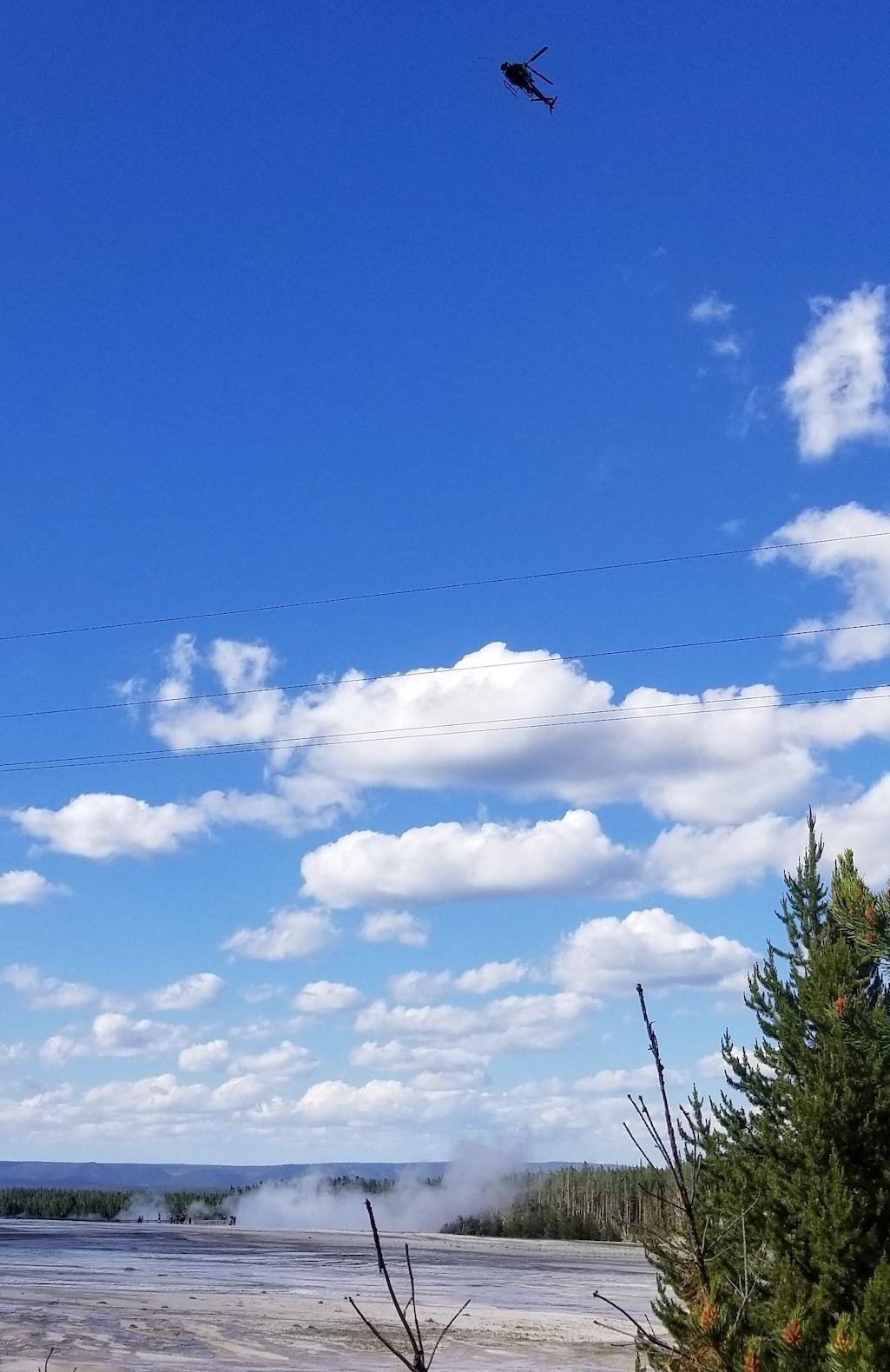
Yellowstone National Park does not have an air tour management plan, but with low-flying helicopters, should it?/Leslie Stoltz
Leslie Stoltz was guiding a group to the overlook of Grand Prismatic Spring in Yellowstone National Park early one summer evening in 2020 when a black helicopter began circling the hot spring, sending a young boy into tears.
"(H)e broke into tears thinking the helicopter was a terrorist," recalled Stoltz, who described the whirlybird as "doing laps over the spring, around and around, way lower than 500 feet."
When she reached out to the park about the incident, she was told the park had no authority over aircraft in Yellowstone.
"The National Park Service was aware of this company flying over the park for an aerial filming project. Since there was no filming from the ground they were not required to have a film permit for Yellowstone," was the response Stoltz received. "I'm sorry that this activity negatively impacted your clients' experience to Yellowstone."
Two dozen parks across the country are in various stages of trying, after 20 years of opportunity, to develop with Federal Aviation Administration input air tour management plans for their parks. Yellowstone is not one of the parks required to do so because it doesn't have a large number of air tours.
"Yellowstone National Park has never had an air tour management plan since the NPS started regulating air tours in 2000, and does not plan to currently enact one," Yellowstone spokesperson Morgan Warthin told the Traveler. "No plan is required until the park exceeds 50 air tours in a year, and to our knowledge we have not exceeded 12 permitted air tours in any given year in the past decade."
While there might not be many "permitted air tours" over Yellowstone, Stoltz claims to have seen many low-flying aircraft in the park. And she is trying to rally other guides in the park, geyser gazers, and other "Yellowstone junkies" to start documenting low-flying aircraft in the park by noting the specific day and time of day that they observe a flight along with any descriptive notes.
"Photos and tail numbers would be even better," she added in an email to colleagues, "but I realize if you are with guests, it may not be possible. I wonder if it will start to show patterns?"
It was 20 years ago that the National Park Air Tour Management Act of 2000 was implemented and required the FAA, in coordination with the NPS, to set limits on overflight numbers, timing, and routes to protect park resources and the visitor experience from noise and disruption in any park with more than 50 overflights a year. After what some saw as intransigence, in May 2020 a federal judge ordered the Park Service and FAA to complete air tour management plans within the next two years for several parks.
This past February the two agencies notified the judge that they would be unable to complete plans for the eight parks with some of the highest levels of air traffic within that deadline. In explaining the delays, the two agencies cited participation by tribal governments (Canyon de Chelly, Glen Canyon, Rainbow Bridge, Mount Rushmore, Badlands), commercial jet traffic and flights to Grand Canyon National Park that are exempt from the 2000 act (Lake Mead), and the high number of current air tours and stakeholders (Hawai'i Volcanoes, Haleakalā).
At Public Employees for Environmental Responsibility, which successfully sued the agencies for not moving more quickly on establishing air tour plans, Jeff Ruch said park superintendents pretty much have their hands tied when it comes to airspace over their parks.
"Park superintendents have discovered their jurisdictions ends at the tree tops," Ruch, PEER's Pacific director, told the Traveler in an email Thursday. "For example, Grand Teton’s [General Management Plan] bans all overflights, but it has no means to enforce that prohibition. It is the FAA that regulates commercial air traffic generally. Notably, the National Park Air Tour Management Plans are developed by the FAA 'in consultation with' NPS, and there’s the rub."

 Support Essential Coverage of Essential Places
Support Essential Coverage of Essential Places




Comments
Reminds me of a cartoon I saw years ago: a couple is in their living room watching a video of a beautiful sunset on their TV ... via the cable running from the video camera outside their large picture window!